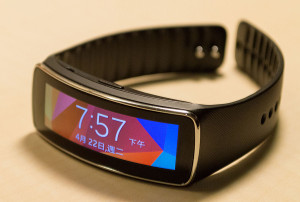Wearable computing is in the news again, with new smart watch offerings from Samsung and others, Nike cutting back their development of wearable technology, and existing and emerging offerings such as Google Glass, the Pebble smart watch and Nike’s FuelBand fitness monitor also attracting growing interest in the media.
But can this diverse range of products from different manufacturers interoperate effectively with each other and with other devices? Are proprietary devices and protocols user friendly in wearable applications, or are open standards and interoperability between different vendors important for success of the wearable computing industry? Let’s look at the need for standards in wearable computing, and the pros and cons of open standards in the context of wearable computing.
Many companies, including smaller startups as well as major international brands such as Google and Nike are attempting to find leading positions in the emerging consumer market for wearable computing. For example MapMyFitness, a company developing an online platform for use with wearable health and fitness data-logging, is aiming to support connectivity with some 400 different devices.
Furthermore they’re one of 10 app makers partnering with Jawbone on its recently announced Up wrist-monitor platform which also aims to attract developers – and that’s just the offering from one small company in the wearable-computing market, focussing on health and fitness devices, such as heart-rate monitors and shoe-mounted exercise loggers.
This type of wearable technology accounts for one of the most rapidly growing sectors of the wearable computing market. But such interoperability with a large number of different devices assumes that open standards and protocols, such as Bluetooth Low Energy and ANT, are widely adopted across the industry.
Although some vendors such as Google are likely to have good support for open standards and strong utilisation of open-source operating systems such as Android, other industry players such as Nike or Apple are much less likely to concern themselves with openness and interoperability if they can bring a product ecosystem to market which “just works” for consumers whilst using closed, proprietary protocols and standards.
Right now, much of the data collected from wrist monitors such as Jawbone’s Up, as well as heart-rate monitors, sleep-pattern sensing devices, bicycling cyclometers and more exist in digital silos. It’s not easy to look at the different collections of data at the same time to determine, for example, if a series of poor running performances might have been related to several nights of fitful sleep.
But if open standards are used, then correlation and fusion of the data from different sources in the same place is possible, allowing more interesting conclusions to be derived from the data. Because of the size, weight, battery life and user interface constraints associated with wearable devices, such devices tend to use relatively low-power microcontrollers – not relatively powerful CPUs like those found in mobile phones, and tend to use minimalist sensors, memory and storage, meaning that each device tends to be optimised to do only one particular task and do it well, unlike general-purpose PCs or smartphones.
Although a Pebble smart watch enhances your user experience when using your smartphone, it’s not a fitness data-logging device – it’s a separate device that fulfils a different basic set of functionality. However, there is still some potential for value in interoperability and data exchange between these kinds of devices.
Wearable electronic devices of this kind can be most useful when multiple devices are combined into networks – for example, a smart watch for at-a-glance message display, a heart rate monitor and a pedometer sensor, all networked back to a central smartphone. But are the full spectrum of wearable devices that you choose to use going to all be compatible with the smartphone you use?
Samsung recently unveiled its first serious piece of wearable computing technology, the Galaxy Gear, although the device is currently only compatible with the Galaxy Note III and the third-generation Galaxy Note 10.1. Although the Sony SmartWatch 2, for example, is widely compatible with Android devices, is it likely that the rumoured Apple iWatch will offer compatibility with Android? Probably not.

On the other hand, it is likely that choosing multiple different devices from the same manufacturer – if the types of sensors and devices you want to use exist – is likely to “just work” with the best possible compatibility and reliability, even if this means promoting closed, locked-in systems and proprietary protocols which may be used. And many non-technical customers just want consumer electronics that “just works” without any real care for open standards.
Today, smart watches and fitness bands can track physical activity through the most basic metrics, such as step counting. With more sophisticated accelerometers and algorithms, devices such as the Nike FuelBand can make a guess at what kind of activity you’re actually doing.
Some devices, like the Basis watch, track heart rate. Combined with a smartphone and/or smart watch, multiple different devices like this comprise a personal, body-worn wireless sensor network of sorts – and open standards are obviously valuable in realising the true flexibility and power of such a network. You can use RunKeeper on your iPhone, for example, or Android phone or via any web browser, but you can’t get RunKeeper’s data to sync with MapMyFitness.
And if you’re using a Nike FuelBand, you can’t translate proprietary Nike “fuel points” into data that’s usable by other fitness-tracking apps. Wouldn’t it be nice if this data was openly portable and easy to integrate into other fitness applications?
Fragmentation of compatibility of hardware and software between different versions of operating systems such as Android and wearable computing devices is also an emerging concern that should be considered, to deliver the best possible user experience. A “companion app” is an application that runs on the smartphone which communicates with the smartwatch or other wearable device in a personal network. Sometimes these apps are available on both major platforms, but sometimes they aren’t.
Even if they are, it often means that a person has to purchase a version of the app for each platform. Companion apps may be increasingly going away, replaced by what amount to “plug-ins” that install into the app that runs in the device’s own app, along with a piece that’s copied onto your smart watch or other wearable device.
But this approach just creates an entirely new microclimate inside each operating system’s ecosystem, which is not ideal. Now smart watch apps must be downloaded into another app which takes care of communication between the two in a cross-platform environment, adding complexity. When we bring Samsung into the equation it gets even worse; now you’ve got to have specific hardware for the peripheral to even work! On paper it may work great, but in reality this is a user experience nightmare, and careful design for user-friendliness along with cross-platform compatibility is important here.
Privacy, of course, becomes a big concern that many people have when it comes to omnipresent wearable cameras recording video at all times, or wearable devices gathering intimate data on what your body is doing, in health or fitness datalogging applications.
At the same time as technical standards and protocols are developed and standardised, society needs to be developing and thinking about social and legal standards to deal with the new technology – to protect the privacy of health data, and to deal with the presence of omnipresent photography and recording in public spaces using devices such as Google Glass without over-the-top hatred or suspicion of the technology due to the privacy concerns.
Device manufacturers can also play a role here, in enabling public understanding and acceptance of what the technology does and does not do, and what measures are put in place to manage the data with good standards of privacy.
Nevertheless the wearable electronics market is growing, and there are many opportunities if the designer can hit the sweet spot of creating a genuinely useful and usable product. And if you have the idea, and looking for a partner to help bring that idea to a finished product – we’re ready to work with you for your success.
As experts not only embedded hardware but also full idea-to-delivery of products, our consultants and engineers can work with you to meet your goals. The first step is to join us for an obligation-free and confidential discussion about your ideas and how we can help bring them to life – click here to contact us, or telephone 1800 810 124.
LX is an award-winning electronics design company based in Sydney, Australia. LX services include full turnkey design, electronics, hardware, software and firmware design. LX specialises in embedded systems and wireless technologies design.
Published by LX Pty Ltd for itself and the LX Group of companies, including LX Design House, LX Solutions and LX Consulting, LX Innovations.


